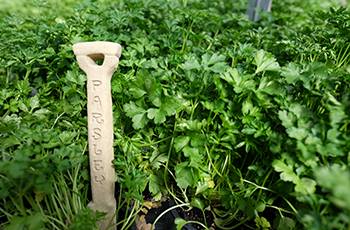 Herbs for spring planting.
Herbs for spring planting.
Gardening has never been one of my talents. I get really excited, and over zealous in the spring, with a car full of vibrant plants and pretty bags of seeds that I dream will soon grow in my garden perfectly enough for a Southern Living cover story. But then it gets hot, and I either over water or under water, and the bugs take over like it’s a buffet. By October I have tomato plants full of green leaves with a couple of tiny tomatoes that I watch carefully until the birds decide they’re worth eating before I can harvest them. But this year is going to be different. I decided to consult with a professional who knows Oklahoma weather, and the plants that thrive in it. As a chef, all I want are plants that produce food I will cook, flowers that are edible, and herbs that will make all my dishes look and taste delicious. Is that too much to ask?
I talked with Lindsey Fladie and asked her some questions about starting a “chef’s garden” in Oklahoma. Here is what I learned:
S: What is the most important factor to consider when planting a vegetable and herb garden?
L: Soil health, sun requirements of plants, and access to water.
S: What are some Oklahoma native plants that you recommend?
L: Prickly pear is a fun one because cactus and succulents are so popular right now. You can eat the pads of the cactus and harvest the fruit. Passion flower vine is great if you have a trellis. Not only does it produce beautiful flowers, it produces fruit as well.
S: What are some tips for growing tomatoes in Oklahoma?
L: Start with good soil full of nutrients. Also, plant tomatoes deep to establish a good root system.
S: Are there flowers that are good to plant in an edible garden to help with pest control?
L: Borage repels hornworms, and has an edible flower. Marigolds cause pests to become confused because of their strong aroma. Plants that attract beneficial insects include borage, cilantro, dill, fennel and sweet alyssum.
S: What are your tips for feeding a vegetable and herb garden?
L: Before planting add a granular fertilizer to the soil, and after planting fertilize with a liquid every 3-4 weeks. Read the recommended doses on the fertilizer label, so you don’t burn the plants or starve them. Herbs don’t require a lot of feeding but use organic liquids such as Neptunes, fish
and seaweed.
Fortunately, I don’t have difficulty growing an abundance of herbs. I use them all year in my recipes, and they add a lot of flavor and color to my dishes. Chimichurri is a tasty herb sauce from Argentina that is commonly served with grilled beef. It’s easy to make in a food processor and makes for a great appetizer with grilled steak skewers. Find more recipes using fresh herbs on my website www.beadsandbasil.com. Meanwhile, I’ve already started planting my chef’s garden, and I have every intention of using my new gardening knowledge to harvest a delicious crop that will make its way into many recipes.
 Fresh parsley ready to plant.
Fresh parsley ready to plant.
Grilled Steak Skewers
with Chimichurri Sauce
Serves 6
Steak and chimichurri is a famous combination in Argentina! Chimichurri is a mixture of herbs, olive oil and aromatics that works perfectly with a grilled steak. This recipe uses steak on skewers to serve as appetizers or over a green salad. Of course, you could also grill the whole steaks to serve as the main course. If there’s any leftover sauce, add some more olive oil and dress a lettuce salad for a blast of great flavor.
Ingredients:
- 3/4 cup olive oil
- 1/3 cup sherry wine vinegar
- 2 tbsp. lemon juice
- 1 cup chopped Italian parsley
- 1/2 cup chopped fresh basil leaves
- 2 tbsp. chopped fresh oregano leaves
- 3 cloves minced garlic
- 1/4 tsp. freshly ground black pepper
- 3/4 tsp. Kosher salt
- 1/4 tsp. crushed red pepper
- 2 pounds beef top sirloin or beef filet
- 12 wooden skewers, soaked in water
In a food processor, combine all ingredients except steak. Pulse to combine. Alternatively, you can blend the ingredients with a mortar and pestle. Do not blend to a puree. Remove half of the sauce and put in a bowl. Reserve remaining sauce.
Cut the steak into 1 1/2” strips and season with salt and pepper. Transfer to a large plastic resealable bag and add the reserved sauce to cover the meat. Refrigerate for at least 30 minutes, and up to 3 hours.
Heat grill or skillet over high heat. Remove meat from bag and shake off excess marinade. Thread the steak strips onto the damp skewers (to prevent them from burning), and grill each strip for about 2 minutes on each side, until medium-rare. Serve with reserved sauce.

See more about Building a Chef's Garden Without a Green Thumb:
https://www.valuenews.com/building-a-chefs-garden-without-a-green-thumb-news-article_4786

